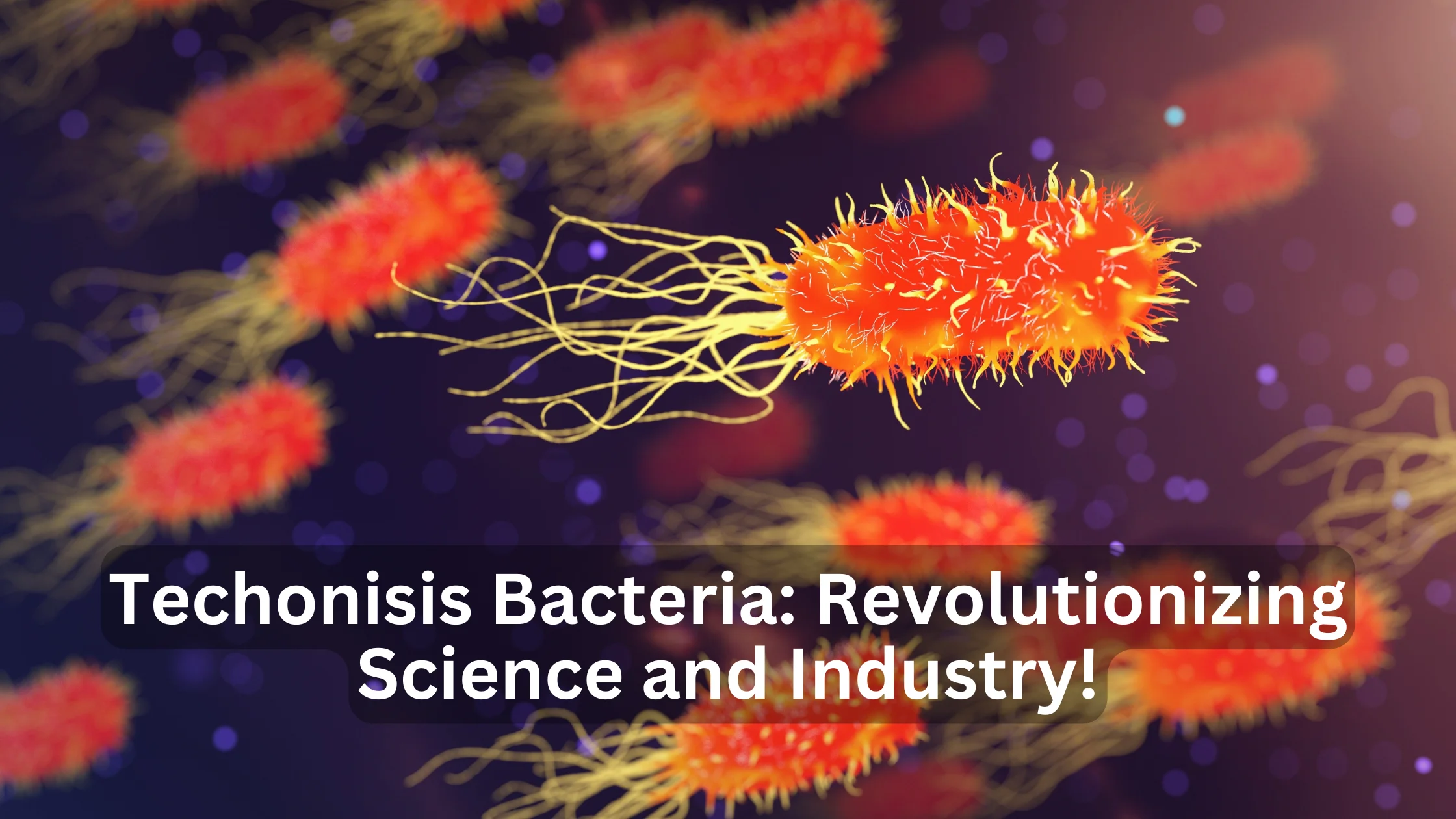- March 10, 2025
Techonisis Bacteria: Revolutionizing Science and Industry!

In recent years, advancements in biotechnology have unlocked the potential of microorganisms that were once overlooked.
Techonisis bacteria represent a unique class of microorganisms engineered or naturally evolved to perform specialized functions.
Whether through natural processes or genetic modification, these bacteria have been harnessed for their ability to thrive in extreme environments and carry out complex biological processes.
Table of Contents
What are Techonisis Bacteria?
The term Techonisis bacteria refers to a group of microorganisms with exceptional technological and industrial applications. The name “Techonisis” merges the concepts of technology and genesis, signifying their ability to drive technological innovations. These bacteria are typically characterized by their resilience, adaptability to a variety of environmental conditions, and their unique biochemical processes.
The primary distinction of Techonisis bacteria lies in their versatile metabolic pathways, which make them suitable for industrial and environmental applications. Through natural evolution or genetic engineering, these bacteria have developed the ability to perform tasks that could not be achieved by other microorganisms.
Their potential lies in their adaptability, sustainability, and specialized functions that enable them to break down pollutants, improve agricultural processes, and even treat diseases.
Historical Background:
The study of Techonisis bacteria dates back to the 1980s, when scientists first identified their unique metabolic pathways in microorganisms thriving in extreme environments such as hot springs, deep-sea vents, and arid deserts. Initially, these bacteria were regarded as a curiosity due to their ability to survive and reproduce under harsh conditions, including high temperatures, pressure, or acidity.
As research progressed, it became clear that these bacteria were not merely surviving; they were thriving due to the specialized biochemical processes that they had developed. This led to a broader understanding of their potential in a variety of applications, ranging from waste treatment to the production of biofuels.
The discovery of Techonisis bacteria represented a significant leap in our understanding of microbiology. Scientists soon recognized that these organisms were far more valuable than just survivors in extreme conditions; they had the potential to drive scientific innovation and solve pressing global issues.
Read Also: Exercises To Strengthen Knees – Know Before You Go!
Unique Characteristics of Techonisis Bacteria!
Techonisis bacteria possess several unique characteristics that set them apart from other microorganisms. Their structure, metabolic processes, and environmental adaptability make them invaluable for a wide range of applications.
- Cellular Structure: Techonisis bacteria have a complex cell structure that allows them to survive in extreme environments. Their cell walls are often more robust than those of regular bacteria, providing enhanced protection against environmental stressors like heat, acidity, or oxidative damage.
- Metabolic Flexibility: One of the most impressive features of Techonisis bacteria is their ability to utilize a variety of energy sources. They can thrive in environments with minimal resources by using specialized metabolic pathways such as anaerobic respiration, photosynthesis, and chemosynthesis.
- Resilience and Adaptability: These bacteria can thrive in diverse habitats, including environments with extreme temperatures, salinity, or acidity. Their metabolic pathways enable them to adapt to environmental changes, making them ideal for use in biotechnological and industrial processes that require adaptability.
- Genetic Potential: Techonisis bacteria have large genomes with high GC content, which contributes to their genetic stability and ability to evolve. This makes them excellent candidates for genetic modification, allowing scientists to engineer them for specific tasks.
Applications of Techonisis Bacteria!
Techonisis bacteria are gaining attention for their potential applications across various industries. Their unique characteristics make them suitable for tackling complex challenges in sectors such as healthcare, environmental management, and biotechnology. Below, we will explore some of the most promising applications of these bacteria.
Healthcare Applications!
Targeted Drug Delivery:
One of the most exciting prospects in healthcare is using Techonisis bacteria for targeted drug delivery. These bacteria can be engineered to recognize specific types of cells, such as cancerous or infected cells, and deliver therapeutic agents directly to those sites.
This approach could revolutionize cancer treatment by reducing side effects and improving drug efficacy. Additionally, some Techonisis bacteria can cross biological barriers like the blood-brain barrier, making them suitable for treating neurological disorders.
Probiotics and Gut Health:
The human gut microbiome plays a critical role in health and disease, and Techonisis bacteria could be tailored to promote gut health. These bacteria could be engineered to produce beneficial compounds such as vitamins or enzymes that support digestion. Furthermore, they could help combat harmful pathogens in the gut, improving digestive health and boosting immunity.
Combating Antibiotic Resistance:
Antibiotic resistance is an ever-growing threat, and Techonisis bacteria offer a promising solution. By producing antimicrobial substances that target resistant pathogens or by disrupting bacterial biofilms (which protect harmful bacteria from antibiotics), these bacteria could play a key role in overcoming antibiotic resistance.
Read Also: Best & Simple Core Strengthening Exercises That You Have to Do At Home
Environmental Applications!
Techonisis bacteria are also revolutionizing environmental science through their applications in bioremediation and waste management. Their ability to break down pollutants and restore ecosystems makes them invaluable tools for mitigating environmental damage.
Bioremediation:
Traditional methods of cleaning up pollutants, such as oil spills or heavy metal contamination, can be costly and inefficient. Techonisis bacteria offer a more sustainable and cost-effective solution. These bacteria can be engineered to degrade toxic compounds into non-toxic substances, providing a natural method for cleaning up pollution.
Waste Management:
Techonisis bacteria can also help manage waste more efficiently. Through processes like anaerobic digestion, these bacteria can convert organic waste into biogas, a renewable source of energy. Additionally, they can aid in recycling efforts by breaking down complex materials, making them easier to recycle and reuse.
Ecosystem Restoration:
In addition to their bioremediation capabilities, Techonisis bacteria can help restore ecosystems by breaking down pollutants and promoting soil health. By enhancing nutrient cycling and improving soil fertility, these bacteria could play a crucial role in regenerating ecosystems impacted by pollution or deforestation.
Industrial Applications!
The industrial sector is rapidly adopting biotechnological innovations, and Techonisis bacteria are at the forefront of this change. From sustainable manufacturing to biofuels, these bacteria are transforming traditional industrial processes.
- Bio-Manufacturing: Manufacturing processes in industries such as chemicals, textiles, and pharmaceuticals are typically resource-intensive and environmentally harmful. Techonisis bacteria can be used in bio-manufacturing processes to produce chemicals, fuels, and materials more sustainably. By utilizing renewable resources and minimizing waste, these bacteria can help industries reduce their environmental footprint.
- Biofuel Production: Techonisis bacteria are highly efficient in converting organic matter into biofuels. They can be used to produce bioethanol, biodiesel, and biogas, offering a cleaner alternative to fossil fuels. The development of biofuels from Techonisis bacteria could significantly reduce greenhouse gas emissions and dependence on non-renewable energy sources.
- Food Production: In the food industry, Techonisis bacteria can improve fermentation processes, enhance food preservation, and even produce new food additives or preservatives. By using these bacteria in food production, manufacturers can reduce reliance on synthetic chemicals and improve the nutritional value and shelf life of food products.
Challenges and Ethical Considerations!
Despite the immense potential of Techonisis bacteria, several challenges must be addressed before their widespread use can be fully realized:
- Ethical Concerns: The genetic modification of bacteria raises ethical questions regarding unintended consequences, such as the release of modified organisms into the environment. Strict regulatory frameworks and safety protocols must be developed to ensure that these bacteria do not pose a risk to human health or ecosystems.
- Public Perception: The use of genetically modified organisms (GMOs) in biotechnology can face public resistance due to concerns about safety and environmental impact. Effective communication and education about the benefits and safety of Techonisis bacteria will be essential for gaining public acceptance.
- Regulatory Hurdles: The use of Techonisis bacteria in industrial and healthcare applications will require rigorous testing and approval from regulatory bodies. Ensuring that these bacteria are safe and effective for human use will be a critical part of their commercialization process.
Future Prospects!
The future of Techonisis bacteria looks promising, with ongoing research focused on advancing their capabilities and applications. Scientists are working on improving the genetic engineering techniques used to modify these bacteria, allowing for more precise control over their functions.
Additionally, new applications in fields such as nanotechnology, artificial intelligence, and sustainable energy are emerging, further expanding the potential of Techonisis bacteria.
The integration of these bacteria with other advanced technologies could lead to synergistic solutions that address some of the world’s most pressing challenges, from climate change to global health crises.
FAQs:
1. What are Techonisis bacteria?
Techonisis bacteria are microorganisms with unique metabolic abilities, used in various biotechnological and environmental applications. They excel in extreme conditions, making them highly adaptable.
2. How are Techonisis bacteria used in healthcare?
These bacteria can be engineered for targeted drug delivery, improving the precision and effectiveness of treatments. They also have potential in probiotics and combating antibiotic resistance.
3. Can Techonisis bacteria help with pollution?
Yes, Techonisis bacteria can break down harmful pollutants in the environment, providing sustainable bioremediation solutions. They help clean up toxins and restore ecosystems.
4. Are Techonisis bacteria used in food production?
In the food industry, they enhance fermentation, improve preservation, and produce beneficial additives. These bacteria offer a more sustainable and natural alternative to chemical preservatives.
5. What industries benefit from Techonisis bacteria?
Techonisis bacteria are utilized in industries like pharmaceuticals, agriculture, waste management, and biofuel production. They contribute to more efficient and eco-friendly processes.
6. How do Techonisis bacteria contribute to biofuel production?
These bacteria can convert organic materials into biofuels, offering a cleaner and renewable energy source.
Conclusion:
Techonisis bacteria are a groundbreaking development in the field of biotechnology, offering solutions to a wide range of challenges across industries and sectors. With their unique metabolic pathways, environmental adaptability, and potential for genetic modification, these bacteria are poised to revolutionize healthcare, environmental science, and industrial manufacturing. As research continues to evolve, the full potential of Techonisis bacteria will likely transform the way we approach sustainability, medicine, and technology in the future.


- March 5, 2025

